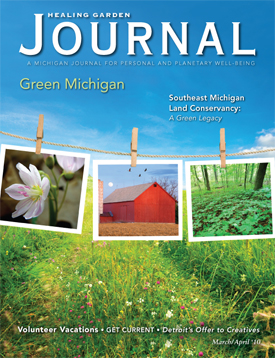March/April Healing Garden Journal Green Lawns- Healthy Planet
Share
by Jeff Copeland
 With Spring peeking around the corner, many of us are starting to think about our gardens and lawn care. This is a good time to stop and think about how our lawn care practices might be impacting the environment. After all, we play an important part in controlling the over- use of NPK (nitrogen, phosphates, potash) and the widespread use of herbicides, pesticides and fungicides. It is very important that we, as homeowners or professional contractors understand the damage being done to human health and the environment.
With Spring peeking around the corner, many of us are starting to think about our gardens and lawn care. This is a good time to stop and think about how our lawn care practices might be impacting the environment. After all, we play an important part in controlling the over- use of NPK (nitrogen, phosphates, potash) and the widespread use of herbicides, pesticides and fungicides. It is very important that we, as homeowners or professional contractors understand the damage being done to human health and the environment.
The first step in the use of any lawn products is to know the square footage of the turf to be treated and to apply only the proper amount needed to cover that area. I use only 1.25 lbs. of Nitrogen per thousand sq. feet per season. not “per application”, zero Phosphates, unless introducing new seed and no herbicides, pesticides or fungicides.
It is also important to be aware of sensitive areas such as parking lots, storm drains, streets, sidewalks, wellheads, lakes, rivers, wetlands; any areas occupied by people or pets. And products should never be applied within 30′ of open water.
As a lawn care professional, I believe that it is never acceptable to see fertilizers, herbicides, pesticides or fungicides on driveways, parking lots or side walks – as these products are then spread into the environment where the damage to human health and the environment has now reached alarming levels.
It is important that we do some research, (searching the web or asking questions), before using these products, to learn the physical health problems related to their use. It is important to learn not only about the active ingredients in these products but also the inactive ingredients, as these too can cause problems and may be dangerous. Watch to see if you know what ingredients and the amounts you or your contractor are using on your lawn. Learn what you are doing to yourself and the environment.
Once we decide that the quality of the air we breathe, the water we drink, and the soil we grow our food in is more important than the use of these products, it becomes exciting to care for our lawns without the use of these herbicides, pesticides and fungicides.
There are many natural and safe products we can use. If you are thinking of using natural products however, watch out for untreated manure, sewage sludge or animal byproducts, as these too can cause problems. Unsterilized manures can contain E coli and anaerobic bacteria; sewage sludge can contain heavy metals, fungus and anaerobic bacteria; animal byproducts can contain pathogens and unwanted illnesses. Remember, sewage and untreated manure are things we don’t want running off into the environment so why do we want it on our lawns?
Corn gluten is a natural product now being used as a natural weed suppressant and fertilizer for grass lawns. In my experience it does not stop weeds from germinating and turns into sugar, which is an ant attractant, ruining lawns. The cost of corn gluten is not economical due to the fact that it takes 50 lbs. per 2000 sq. feet per application.
Composting is a good way to use up our organic waste and makes a great natural fertilizer. Remember though, that if your waste/compost ingredients are from toxic products your compost is toxic, if it is made from the waste of safe ingredients it is safe.
Many of our natural methods work as well or better than the herbicides, pesticides and fungicides we have been raised with. The more we practice safe turf care methods without these products the more we are learning that they are not needed. Remember, it is up to all of us, who need water, air and soil to live, to leave behind a safe environment for future generations.
